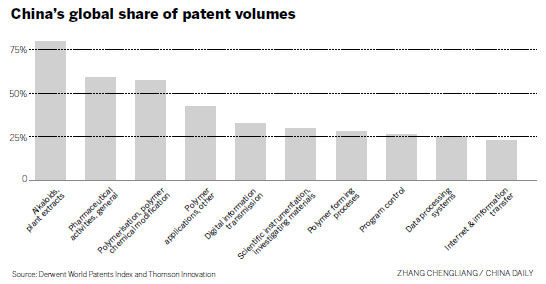Leading information service provider Thomson Reuters unveiled its China's Innovation Quotient report at a seminar in Chinese innovation hub Zhongguancun themed "intellectual property strategy with global vision".
The report noted that intellectual property is a central part of China's national strategy as it pushes to become an innovation-driven economy. It also said effective IP protection was necessary for China to successfully continue on that journey.
China "continues to overshadow other countries" in the volume of its patent applications published each year, according to the report. The growth is driven by the 12th Five-Year Plan and the associated Chinese National Patent Development Strategy (2011-2020), which outlines specific patent targets.
The surge in innovation is increasingly being driven by domestic entities. The report found that last year about 80 percent of Chinese patents originated from China, while in 2007 overseas entities contributed nearly half.
Despite a 16.3 percent increase in published patent applications in 2013 compared to 2012, the report noted that "there is, however, a question as to the quality of these patents".
The perception of low quality inventions may be due to the substantial use of utility models and design patent options used by Chinese inventors.
"Utility models in particular require a lesser standard of novelty than invention patents and so are likely to be of lesser quality than invention patents," the report said.
China's technology profile breaks down roughly into two general areas. Firstly digital computing, processing and communication technology, and secondly- pharmaceuticals, natural products and polymer technology.
China has nearly 80 percent of the world's share in patents for alkaloid and plant extracts and about a 60 percent global share for pharmaceutical activity and general patents.
Guo Li, managing director of Thomson Reuters' IP and science business in China, said that there would be challenges in patent maintenance and protection in the alkaloids and plant extract sector, as it is made up of thousands of traditional Chinese medicine patents mainly developed by individual inventors, rather than universities or corporate entities.
Analysts studied Chinese inventions published in 2008 in the field of data processing by looking at the number of times they were cited by later published inventions, as "it is widely accepted that the more often an invention is cited by later inventions, the more valuable that invention is perceived to be".
They found that the 13,000 Chinese invention patent applications for data processing in 2008 were each cited 1.17 times on average by later inventions. The figure was 6.72 in the US, 1.82 in Japan, 1.31 in Europe and 0.76 in South Korea.
The report projected that China will continue to outstrip other regions to produce more than 900,000 invention patent applications by 2018.
The number of patent lawsuits almost tripled from 2006 to 2013. The slow growth before the new patent law in 2009 and the acceleration after that suggest that the legal changes have brought greater certainty for patent owners.
China is commonly perceived as an "unfair playing field" for foreign litigants, but analysis of patent cases would suggest otherwise, the report said.
Analysts found a 75 percent win rate by foreign plaintiffs against domestic defendants in patent litigation since 2006. The rate for domestic plaintiffs against foreign defendants was 63 percent.
The average statutory compensation award for a foreign plaintiff exceeded that of domestic plaintiffs by 72 percent.
The report was the fourth in the continuing series "Patented in China", which aims to provide insights into China as an emerging economy to better understand how its growth is being driven by attempts to harness the potential of human and natural resources through innovation and the global IP system.
The first report was published in 2008 and two sequels were made in 2010 and 2011.
zhangzhao@chinadaily.com.cn

